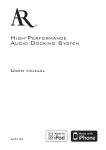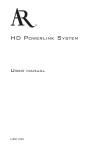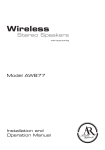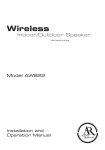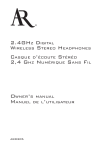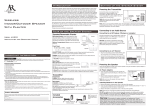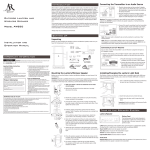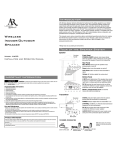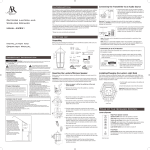Download Acoustic Research AW-871 Specifications
Transcript
900MHz WIRELESS STEREO SPEAKERS Model AW871 Installation and Operation Manual Table of Contents I. Location of functions………..……………………………………………. II. Connecting the speaker system………..……………………………….. III. Adjusting the transmitter………..………………………………………. IV. Tuning the speakers………..…………………………………………….. V. Turning the speakers off………..………………………………………... VI. Recharging the batteries………..……………………………………….. VII. More helpful information ………..……………………………………… VIII.Troubleshooting………..……………………………………………........ IX. Specifications & Features ………..……………………………………… 2 3 5 6 7 7 7 9 10 X. Warranty ………..…………………………………………….................. 11 Introduction AR Wireless Stereo Speakers eliminate the hardest part of adding speakers to almost any location in your home – running and hiding hundreds of feet of speaker wire. Like FM radio, the AR Wireless Speaker System’s 900MHz signal travels with ease through walls, floors, ceilings and other obstacles, delivering high-quality stereo sound virtually anywhere inside the house or out. With drift- and static-free reception along with outstanding range – up to 300 feet* – the possibilities for enjoying your AR Wireless Speaker System are nearly unlimited. AR Wireless Stereo Speakers are compatible with most audio sources, such as TVs, DVD players, VCRs, A/V receivers/amps, stereos, computers, and portable devices (CD players, cassette players, MP3, players, etc.). This manual covers various connection options and detailed operating instructions for making AR Wireless Speakers a valued part of your lifestyle. If, after having reviewed the instructions, you have any questions, please contact our Customer Service Department at 1-800-732-6866. *Range may vary according to environment. 1 I. Location of Functions Speaker Front View: Speaker Back View: G B A E D F C C.Power/volume/scan control D.Battery compartment cover E.Speaker power input jack F. Left/mono/right switch G.Carrying handle Transmitter Front View: Transmitter Back View: A.Tuning indicator light (tuned) B.Standby/Charging indicator light (stdby/chrg) J K I H I. Transmitter power input jack J. Audio input cable K.Channel select switch H.Power indicator light Accessories: O. 1/4” headphone adapter IMPORTANT: These power units are intended to be correctly inserted in a vertical or floor mount position. dio Output L. Transmitter AC power adapter - 12V DC N. “Y” adapter cable M. Speaker AC power adapter (x2) - 18V DC 2 Audio Output II. Connecting the Speaker System Audio Output I. Powering the Transmitter Connect the small, round plug from the transmitter AC power adapter (L) to the transmitter power input jack (I) and plug the other end of the transmitter Sortie audio AC power adapter (L) into any standard 120V AC wall outlet. Audio Output Note: Be sure to use the AC power adapter rated 12V DC 100 mA. Sortie audio Note: There is no transmitter ON/OFF switch. The transmitter is designed to be left plugged in and powered at all times. If you do not intend to use the AW871 for an extended period of time, you may wish to unplug the transmitter AC power adapter. Transmitter 120V AC wall outlet I AC Power Adapter (L) II. Connecting to an Audio Source: i. Connecting to an A/V Receiver: 1. Connect the included “Y” adapter cable (N) to the 3.5mm mini plug cable coming out of the transmitter. 2. “Y” adapter cable (N) Audio Output Audio Input Cable (J) ii. Connecting to a TV: 1. TV Transmitter Audio Output AW871 Connect the RCA-type left (white) and right (red) audio plugs on the ”Y” adapter cable to the corresponding left and right audio outputs of your A/V receiver, amp or other audio source. 3 1/4” headphone adapter (O) Battery Battery Battery Battery Audio Input Cable (J) Battery Stereo Battery Sortie audio Battery Transmitter Battery Sortie audio Battery iii. Connecting to a Stereo or a Computer: Battery Audio Input Cable (J) Connect the RCA-type left (white) and right (red) audio AW811 plugs on the “Y” adapter cable to the corresponding left and right audio outputs on the TV. Battery 2. “Y” adapter cable (N) Audio Output Connect the included “Y” adapter cable (N) to the 3.5mm mini plug cable coming out of the Sortie audio transmitter. AW811 Battery Battery Battery Battery Battery Battery Battery Battery Battery Audio Output Battery Audio Output Battery AW811 Battery A/V Receiver Battery Audio Output Transmitter AW871 Plug the cable coming out of the AW871 transmitter into the headphone output of your stereo or the audio output jack on your computer. Use the included 1/4” headphone adapter (P) to convert the 3.5mm plug to a 1/4” plug as needed. Warning: This product is designed to work with line level outputs or headphone outputs only. DO NOT connect it directly to speaker outputs, as it will permanently damage the transmitter. III. Powering the Speakers There are two options to power your wireless speakers: i. AC Power Adapter: Speaker AC Power adapter (M) Speaker power input jack (E) AW811 Battery Battery Battery Battery Battery Battery compartment cover (D) Battery Battery Battery ii. C-cell Batteries: AW871 AW811 1. Turn the speaker volume down by rotating the power/volume/scan control (C) on the front of the speaker all the way to the left. 2. Insert the small, round plug from one speaker AC power adapter (M) into the speaker power input jack (E). 3. Plug the other end of the speaker AC power adapter into any standard 120V AC wall outlet. Note: Be sure to use the speaker AC power adapters rated 18V DC 700 mA. 1. Turn the speaker volume down by rotating the power/volume/scan control (C) on the front of a speaker all the way to the left. 2. 3. 4. Remove the battery compartment cover (D) on the rear of a speaker. Insert eight (8) C-cell batteries (not included) into the speaker following the polarity (“+” and “–”) as diagrammed inside the battery compartment. Replace the battery compartment cover. Battery Battery Battery Battery Battery Battery Battery Battery Important: If you are using NiMH or NiCd batteries, the batteries will charge when the headphones are powered with the AC power adapter. Do not power the headphones with the AC power adapter if you installed alkaline or other non-rechargeable batteries—this could cause the batteries to leak. Do not mix batteries with different chemistry types (for example, a zinc battery with an alkaline battery). Do not mix new and used batteries. Do not leave batteries installed in the product when not in use for long periods. AW871 4 III. Adjusting the Transmitter J I K H H.Power indicator light I. Transmitter power input jack J. Audio input cable K.Channel select switch 1. Turn ON your audio source (i.e., A/V receiver, TV, stereo, etc.) and play music at a normal listening volume. 2. 5 Set the channel select switch (K) on the back of the transmitter to 1, 2 or 3. The transmitter provides three different broadcasting frequencies. In the event that you experience poor reception or interference, try choosing a different frequency by moving the channel select switch to another position. IV. Tuning the Speakers B A F C A.Tuning indicator light (tuned) B.Standby/Charging indicator F. Left/mono/right switch light (stdby/chrg) C.Power/volume/scan control 1. Push the power/volume/scan controls (C) to turn each speaker ON. The standby/charging indicators (B) will illuminate red while the speakers are tuning to the transmitter. The “tuned” indicators (A) will illuminate blue, indicating that the speakers are tuned to the transmitter, and you should hear sound coming from the speakers. Note: Once the speakers have tuned to the transmitter and the blue “tuned” indicators are on, the red “standby/charging” indicators will turn off. 2. Adjust volume on each speaker as desired. 3. For stereo operation, set the left/mono/right switch (F) to “left” on the speaker located to the left of the listener, and set the other speaker to “right” position. Set each speaker to “mono” for the best audio quality, if you plan on using one speaker in a different room from the other. 4. The speaker will automatically retune if it loses the signal from the transmitter. However, you can also push the power/volume/scan control to retune the speaker at any time. While the speaker is tuning, the blue “tuned” indicator will turn off and the red “standby/charging” light will be lit. After locking onto the transmitter signal, the blue “tuned” indicator will come back on and the red “standby/charging” indicator light will turn off. Note: Interference in the form of static and/or distortion can sometimes be heard. If this occurs, confirm the transmitter/speaker adjustments and indicators. If the problem persists, refer to the Troubleshooting section of this manual. 6 V. Turning the Speakers Off 1. Push and hold the power/volume/scan control (C) to turn each speaker OFF. You will need to hold the control for about 1.5 seconds for the speaker to turn off. 2. Confirm that the speaker is off by verifying that the red “standby/charging” light and the blue “tuned” light are off. Note: If rechargeable batteries are installed (NiMH or NiCd only) and the speakers remain plugged in via the AC power adapters, the left “standby/charging” indicator light will glow green, even after the speakers have been turned off, indicating that the rechargeable batteries are being charged. VI. Recharging the Batteries The speaker will automatically charge the rechargeable batteries when the batteries are installed and the speaker is plugged in with the AC power adapter. The “standby/charging” indicator (B) will light up green to confirm that the batteries are being charged. Warning: The AW871 built-in charger will charge rechargeable NiMH or NiCd batteries only. DO NOT attempt to charge any other batteries except those specified above. Warning: If alkaline or other non-rechargeable batteries are installed, DO NOT plug in the speakers using the AC power adapters. This can cause the batteries to leak and damage the speakers. Only use rechargeable batteries if you intend to keep the speakers plugged in. VII. More Helpful Information i. About Fixed-Level Audio Outputs: A fixed-level, or line-level audio output is considered ideal since it provides an audio signal unchanged by adjustments to the audio source (stereo, etc.) volume control. 7 Hint: Fixed-level audio outputs from stereo receivers/amps will typically be designated as Tape, Tape 1, and Tape 2 outputs, or VCR audio output connections. These outputs are frequently marked on A/V equipment as ‘TAPE OUTPUT,’ ‘TAPE OUT,’ ‘TAPE REC, or ‘TAPE RECORD or REC OUT.’ Please note: Jacks labeled PHONO, CD, LD, DVD or tape or VCR playback (PB) are INPUTS and will not work with the transmitter. Fixed-level outputs from TVs are usually marked as ‘Constant,’ ‘Fixed,’ or ‘Select.’ If they are not marked as such, they are probably variable outputs (see “About Variable-Level Audio Outputs” below). Outputs from VCRs are almost always fixed. Hint: When connecting to the audio outputs of a VCR, remember that the VCR must be playing a tape or showing a TV channel for sound to be produced. Hint: If your VCR (or other audio source with RCA jacks) only has a single audio output, you will need another RCA “Y” cable. It differs from the “Y” Cable Adapter included with these speakers. It will have a single male RCA plug and 2 female RCA jacks. Connect the dual RCA plugs from the included “Y” cable adapter to the 2 female RCA jacks on the second “Y” cable, and then connect the single male RCA plug of the second “Y” cable to the single audio output of the VCR. ii. About Variable-Level Audio Outputs: A variable-level output, such as a headphone jack or certain RCA-type outputs, provides an audio signal that changes with the volume level set on the audio source (stereo, etc.). As the volume of the audio source is adjusted up and down, so is the audio signal strength sent to the transmitter. This can affect the quality of sound generated by the speakers, and may require an adjustment of the volume level of the audio source to produce a signal strong enough for the transmitter. Hint: On most bookshelf-type or compact stereo systems, inserting a headphone plug into the headphone jack results in automatic cutoff of the regular, or hard-wired speakers. Hint: Most TVs, regardless of age or price, have variable outputs. If you are unsure which of your TV audio outputs is fixed, refer to the TV instruction manual. Some TVs have outputs that can switch between variable and fixed. When given a choice, fixed is always recommended. 8 VIII. Troubleshooting The following troubleshooting guide takes you through some of the more common problems associated with the installation and/or operation of a wireless system. If the problem persists, please call 1-800-732-6866 and a knowledgeable customer service representative will assist you. Issue: Cause and solution: No sound • Check that the transmitter AC power adapter is fully inserted into the wall outlet and the power cord from the AC adapter is firmly connected to the transmitter power input jack. • Confirm that the speakers are turned ON and tuned to the transmitter – the blue “tuned” indicator light should be glowing steadily. • Confirm that the speaker AC power adapters are fully inserted into the wall outlet and the power cord from each AC power adapter is firmly connected to the speaker power input jack. or • Check that the C-cell batteries are fresh and inserted with correct polarity (+, –). • Check that the audio source component (stereo, TV, etc.) is turned on and transmitting sound as it normally should. • Check that the speaker volume is turned up. • If you are using a Tape 2 Monitor output from your receiver/amp as the audio output, check that you have pressed the Tape Monitor/Tape 2 button on the front of the receiver. This will turn on the Tape 2 outputs, which may not have been active. Issue: Cause and solution: No sound/ distortion/ static • • • • • 9 When using battery power, make sure the batteries are fresh and replace if necessary. Check that the speaker “tuned” indicator light is illuminated blue. Change the position of the channel select switch (1, 2 or 3) to change the operating frequency. The speaker will detect the loss of signal and retune automatically. However, you can also press the power/volume/scan control once to make the speaker retune. Change the location of the transmitter. Place it as high and away from obstructions as possible. Avoid placing the transmitter directly on top of or behind a TV. Move the transmitter and speakers closer together. Sending the signal through certain materials, such as glass, tile, and metal, can decrease the effective transmitting distance of the system. IX. Specifications & Features Transmitter Omnidirectional Effective transmitting range: up to 300 feet* 3 selectable broadcast frequencies (between 912.5 and 914.5 MHz) Line audio input with 3.5mm stereo mini plug (1/4" headphone adapter and “Y” cable included) UL-listed AC power adapter Speakers Push-button, auto-lock tuning 10 Watts per channel RMS (each speaker) Two-way acoustic suspension design 1" dome tweeter; 4" woofer Integrated power/tuning/volume control (front face) Left/mono/right switch (rear face) Frequency response: 20Hz - 20kHz Signal-to-noise ratio > 55dB Stereo separation > 20dB Distortion: < 1.5% *Maximum range; results may vary according to environment. This device complies with part 15 of the FCC rules. Operation is subject to the following two conditions: 1) This device may not cause harmful interference and 2)This device must accept any interference received, including interference that may cause undesired operation. Changes or modifications not expressly approved by the party responsible for compliance could void the users authority to operate the equipment. Features and specifications subject to change without notice. 10 X. Warranty 12 MONTH LIMITED WARRANTY Audiovox Electronics Corporation (the “Company”) warrants to the original retail purchaser of this product that should this product or any part thereof, under normal use and conditions, be proven defective in material or workmanship within 12 months from the date of original purchase, such defect(s) will be repaired or replaced (at the Company’s option) without charge for parts and repair labor. To obtain repair or replacement within the terms of this Warranty, the product along with any accessories included in the original packaging is to be delivered with proof of warranty coverage (e.g. dated bill of sale), specification of defect(s), transportation prepaid, to the Company at the address shown below. Do not return this product to the Retailer. This Warranty is not transferable and does not cover product purchased, serviced or used outside the United States or Canada. The warranty does not extend to the elimination of externally generated static or noise, to costs incurred for the installation, removal or reinstallation of the product. The warranty does not apply to any product or part thereof which, in the opinion of the company, has suffered or been damaged through alteration, improper installation, mishandling, misuse, neglect, accident or exposure to moisture. This warranty does not apply to damage caused by an AC adapter not provided with the product, or by leaving non-rechargeable batteries in the product while plugged into an AC outlet. THE EXTENT OF THE COMPANY’S LIABILITY UNDER THIS WARRANTY IS LIMITED TO THE REPAIR OR REPLACEMENT PROVIDED ABOVE AND, IN NO EVENT, SHALL THE COMPANY’S LIABILITY EXCEED THE PURCHASE PRICE PAID BY PURCHASER FOR THE PRODUCT. This Warranty is in lieu of all other express warranties or liabilities. ANY IMPLIED WARRANTIES, INCLUDING ANY IMPLIED WARRANTY OF MERCHANTABILITY OR FITNESS FOR A PARTICULAR PURPOSE, SHALL BE LIMITED TO DURATION OF THIS WARRANTY. ANY ACTION FOR BREACH OF ANY WARRANTY HEREUNDER, INCLUDING ANY IMPLIED WARRANTY, MUST BE BROUGHT WITHIN A PERIOD OF 24 MONTHS FROM THE DATE OF ORIGINAL PURCHASE. IN NO CASE SHALL THE COMPANY BE LIABLE FOR ANY CONSEQUENTIAL OR INCIDENTAL DAMAGES WHATSOEVER. No person or representative is authorized to assume for the Company any liability other than expressed herein in connection with the sale of this product. Some states/provinces do not allow limitations on how long an implied warranty lasts or the exclusion or limitation of incidental or consequential damage so the above limitations or exclusions may not apply to you. This Warranty gives you specific legal rights and you may also have other rights which vary from state/province to state/province. U.S.A.: Audiovox Electronics Corporation, 150 Marcus Blvd., Hauppauge, New York 11788 CANADA: Audiovox Return Center, c/o Genco, 6685 Kennedy Road, Unit 3, Door 16, Mississauga, Ontario L5T 3A5 © 2007 Audiovox Accessories Corporation 111 Congressional Blvd., Suite 350 Carmel, IN 46032 USA AD_39363 06/07 11 www.araccessories.com MADE IN CHINA















